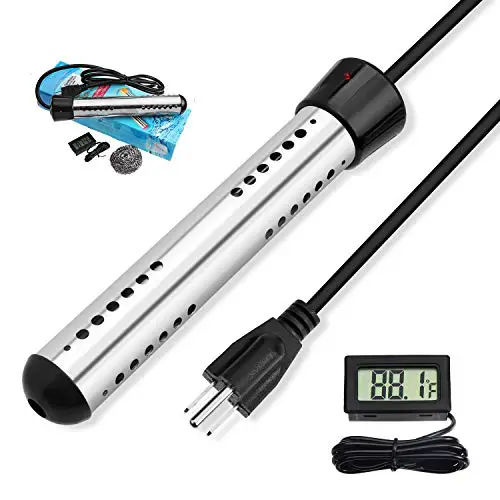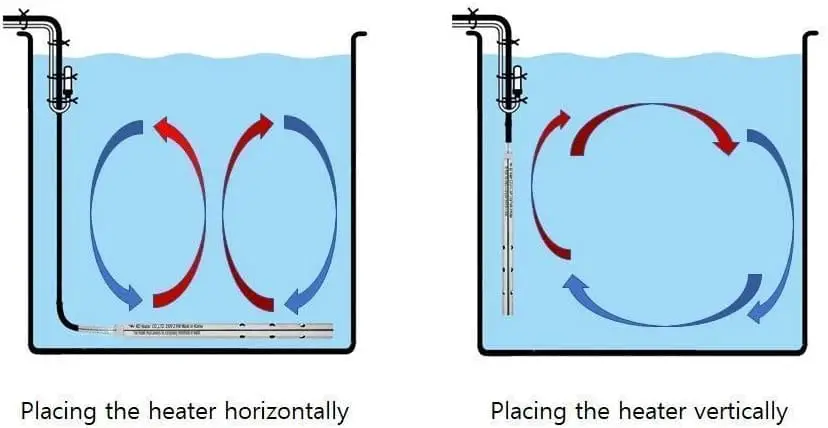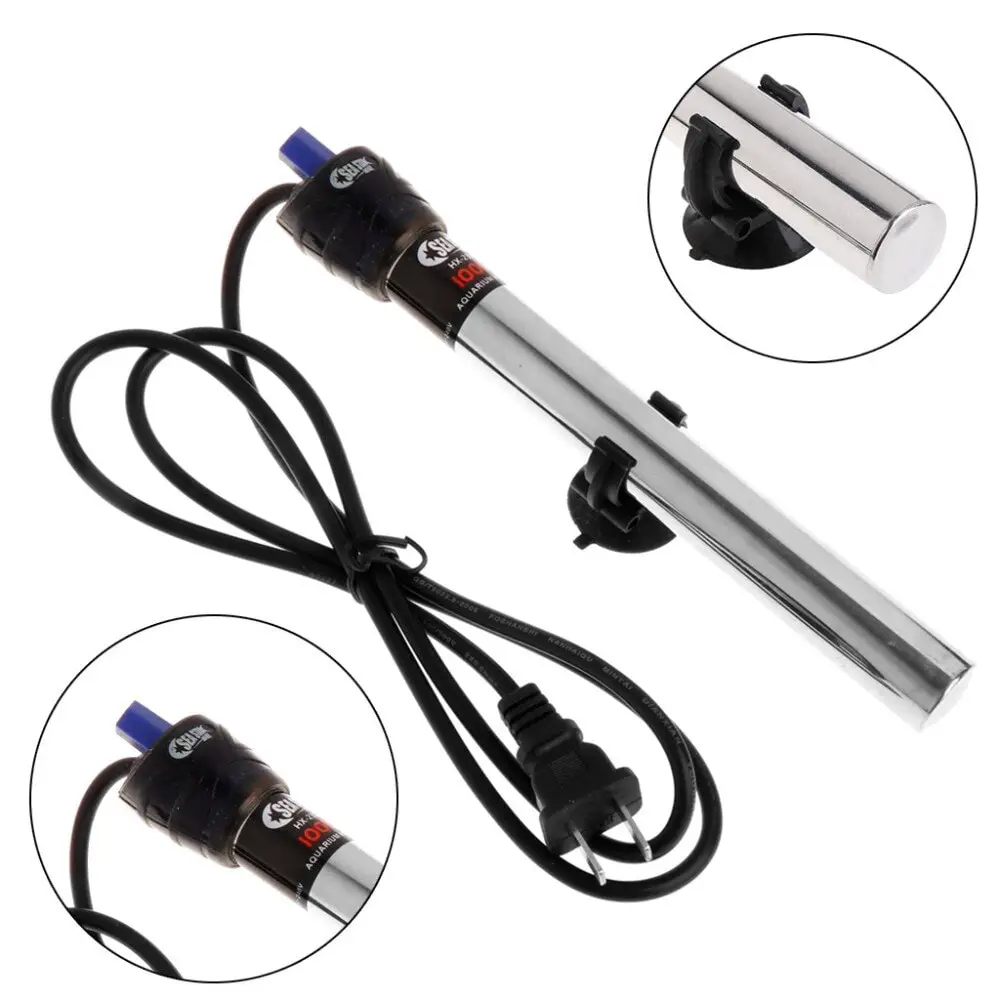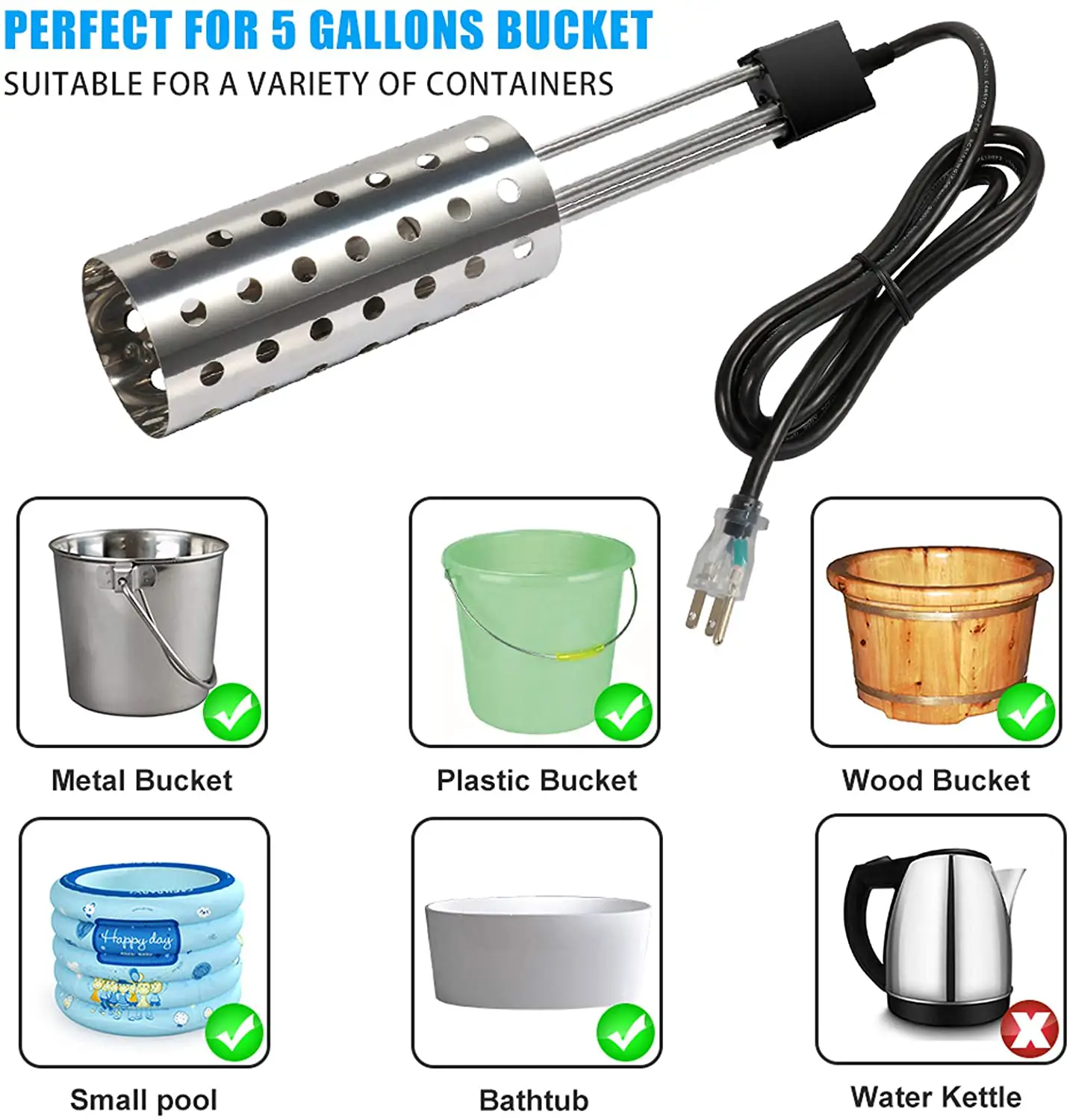Submersible water heaters are always useful items to have around the home or when traveling.
They are generally lightweight, and usually fairly inexpensive.
In this article, we will be reviewing our picks for submersible water heaters, in various categories. Consider the information we will present here before making your purchase.
At a Glance: Our Top Picks for Submersible Water Heaters
- OUR TOP PICK: Gesail Electric Immersion Heater
- BEST BUDGET OPTION: KINGWORK KW011
- BEST SUBMERSIBLE WATER HEATER WITH THERMOSTAT: KD Heater 1300W Titanium
Comparison of the Best Submersible Water Heaters
| IMAGE | PRODUCT | |
|---|---|---|
Our Top Pick  |
| View Latest Price → |
Best Budget Option  |
| View Latest Price → |
 |
| View Latest Price → |
 |
| View Latest Price → |
What to Look For in a Submersible Water Heater
If you have never purchased a submersible water heater before, then this article looks at some important factors to help you choose the correct heater.
Temperature
Do you require the heater to boil water, or merely warm it? A maximum temperature of, say 185°F (85°C), will not boil water. A thermostat of a significantly higher temperature will boil the water, and this is an important factor to consider.
Controllability
If you will be using the submersible water heater for a variety of functions, it would be best to purchase a heater with an adjustable thermostat, preferably with a wide temperature range.
This will give you the versatility to keep water at a mildly warm temperature or maintain a constantly high temperature. If you choose a fixed output heater, there are other considerations. For instance, what is the maximum temperature it will reach?
Would that suit your needs? If a fixed thermostat has a cut-off function, it will maintain the maximum temperature, one without that function will not.

Safety
Identify what the safety features of each heater are. To avoid damage to the heater, or even start a fire, we recommend that you choose a heater that has at least a dry run cut-off function. This will prevent the element from overheating should water evaporate, or the unit removed from the container while switched on.
Choose a heater that has a metal guard, as opposed to a naked element. Touching a hot element can result in a nasty burn, whereas touching the guard while it is hot may not be as severe. Fully submersible type heaters will generally be safer than the over-the-side hanging type immersion heaters.
Should the latter accidentally be knocked into the water, it will most certainly cause an electrical short circuit, and the water will become extremely dangerous to touch. We suggest that you not touch the water while any portable is in it anyway. A fully submersible water heater will have superior sealing on the unit and power cable, thus much safer by design.
Build Materials
When choosing your submersible water heater, find out what materials the working area is made from. At a minimum, we recommend 304 Stainless Steel, as this offers good heat dispersion while being resistant to corrosion and rusting.
Some more upmarket models may use titanium in the construction of the heater’s wet end, and this, although pricey, has the added benefit of being almost non-conductive electrically, thereby reducing the risk of shock.
Review of the Best Submersible Water Heaters
Here we review some of the products that we feel are the best in their respective categories.
Best Overall
Gesail Electric Immersion Heater
Specifications
Power Output: 1500W, 120V, 12.5A
Thermostat: Range of 180 – 194°F (82 – 90°C)
Materials: Stainless 304 steel tube and guard
Safety Feature(s): Dry run auto shut-off facility
Warranty: 12-month manufacturers warranty
We may earn commission from purchases made from our links, at no additional cost to you
Review
This is a simple, no-frills heater. It is best used for heating moderate quantities of water for a variety of applications, such as personal ablutions, car washing, and animal feeding. Due to the built-in thermostat being set at a maximum that is below boiling point, there is little risk of scalding from the water.
The downside is that as the thermostat is not manually adjustable, you will have to keep manually checking the actual temperature of the water until it reaches the heat you require. It is simple to operate, just plug in the 5.9ft cord into a regular wall socket, turn it on, and immerse it in a bucket or other container filled with water.
Bottom Line
We like the simplicity of the Gesail heater: no fuss, no-frills. It should prove to be reliable in the long term. The automatic shutdown feature will protect the user and the device. It is fairly priced, so pretty good value for money too.
Pros
Simple operation, plugin, and use
Automatic temperature shut-off if dry
Rapid heating of small volumes (5 gal)
Cons
Will not boil water
No manual temperature regulation
Best for the Money
KINGWORK KW011

Specifications
Power Output: 1000W, 120V
Thermostat: Fixed at 190°F (87.7°C)
Materials: Stainless 304 steel tube and guard
Safety Feature(s): Dry overheat cut-off
Warranty: Value 12-month manufacturers warranty
We may earn commission from purchases made from our links, at no additional cost to you
Review
Another entry-level water heater, useful for warming quantities of water around 5 gallons. The thermostat is factory set at 190°F and is not adjustable. At 3 inches in diameter, the unit is compact, and the ventilated stainless steel guard prevents one from touching the element directly while allowing liquid to circulate through it. There is a light on the plug to indicate when power is on.
As there is no manual adjustment of the thermostat, you will have to monitor the temperature of the water yourself until it reaches the required temperature. Alternatively, you can let it heat until the maximum temperature, at which stage it will regulate. The unit must be completely immersed in water to achieve maximum performance.
Bottom Line
This heater is basic and easy to use. It is safe if used correctly, and competitively priced, so fair value. The downside is the lack of thermostat control, but that seems to be the case for most entry-level submersible water heaters. The Kingwork KW011 is good for its intended purpose.
Pros
Easy to operate
Will shut down if operated dry
Heats 5 gal of water in 20 min
Cons
Will not boil water
No manual control of the thermostat
Best Submersible Water Heater With a Thermostat
KD Heater 1300W Titanium

Specifications
Power Output: Power 1300W, 120V
Thermostat: Controllable from 32 – 248°F (0 – 120°C)
Materials: Titanium tube, Stainless steel guard
Safety Feature(s): Overheat cut-off
We may earn commission from purchases made from our links, at no additional cost to you
Review
This is a very capable product indeed. We liked the wide temperature range, which covers from cold to well over the boiling point of water. The user-controllable thermostat is an excellent feature, allowing you to set the temperature of the heater and leave it unattended.
The heater will then maintain the temperature of the water indefinitely, leaving you free to do other tasks. The titanium construction ensures no tarnishing of the surface and is also virtually non-conductive, so the risk of shock is minimal. The unit does need to be fully submerged while operating. The long, sealed cable permits heating in depths of up to almost 5ft.
Bottom Line
Although it’s a little pricey, we found the KD 1300W Titanium to be a very versatile and useful submersible water heater. The biggest draws of this product have to be the controllable thermostat and the operating depth of up to 1.5m. We highly recommend that you consider this heater.
Pros
Can boil water
Titanium element
Fully submersible in water, up to 1.5m
Large temperature range on the controllable analog thermostat
Can leave unattended, the heater will maintain the water at a constant temperature
Cons
Pricing
Best Submersible Heater For a Bathtub
CAMTOA Immersion Heater
Specifications
Power Output: 1500W, 120V
Thermostat: Fixed Temperature
Materials: Stainless steel tube and guard, plastic end covers
Safety Feature(s): No overheat cut-off
Warranty: Unconfirmed
We may earn commission from purchases made from our links, at no additional cost to you
Review
This entry-level submersible water heater has the advantage of being able to be used while fully submerged, as opposed to being immersed in the bathtub or container. This allows for use in slightly deeper containers and will provide better heat circulation than the “hang-in” type.
There is no set thermostat, so control of the heating process must be done manually, using the digital thermometer supplied with the unit. This obviously means that the heater should not be left to operate unattended. The unit can reach boiling point in the water, so caution is called for if you want your water temperature below that.
Bottom Line
It is well priced at the lower end of the scale. We felt it to be useful for basic requirements. Its uncapped temperature allows it to bring water to boiling point, but preferably under supervision. This submersible heater is simple to operate and can be fully submerged for better heat circulation. The CAMTOA Immersion Heater is worth a look.
Pros
Can boil water
Easy to operate and maintain
Supplied with a digital thermometer
Can be completely submerged in water
Cons
No dry operation cut-off
No controllable thermostat
Needs constant observation
JESTOP JS-1500w

Specifications
Power Output: 1500W, 120V
Thermostat: Reaches heats beyond 248°F (120°C)
Materials: Stainless 304 steel tube and guard
Safety Feature(s): NO overheat cut-off
Warranty: 30-day distributors warranty
We may earn commission from purchases made from our links, at no additional cost to you
Review
This heater is as powerful as the winning heater, however, with no thermostat cut-off temperature, you can reach boiling temperature with this unit. A digital thermometer is provided in the package with the Jestop immersible water heater, so you will be able to heat the water to a fairly accurate temperature, before removing the heater.
The downside of not having a cut-off temperature means that the heater should only be used under constant observation, which should be the case with any submersible heater that you choose anyway. The 30-day warranty offered by the distributors is of concern, considering most of the others in this category will offer 12 months. It is favorably priced.
Bottom Line
This heater is good value for money and the added bonus in some respects is that it will heat up to beyond boiling point. The thermometer that is supplied with the product is a handy accessory that most of the opposition lacks. This heater is certainly worth considering, despite the warranty concern.
Pros
Easy to use
Can boil water
Rapid heating of water
Includes a digital thermometer
Cons
No adjustable thermostat
Does not have an overheat cut-off
What is a Submersible/Immersion Water Heater?
A submersible, or immersible water heater, is an electrical element, similar to the one you would find in your kitchen kettle at home. These can either be fixed into a tank or vessel or be fully portable, like the ones we have reviewed here.
The advantage of the portable submersible heater is that it can be used anywhere where there is an electrical power socket and they are storable when not in use. This portability makes them ideal for site work, traveling, industrial work, or heating liquids around the home.
How Do Submersible Heaters Work?
Submersible heaters work by radiating heat from an electrical element, usually made of stainless steel, into the liquid in which it is immersed or submerged. The element can be direct electricity, giving off a fixed amount of heat, or be controlled through a thermostat, which can either be a fixed output, or variably adjustable.
Once the heater is submerged or immersed in water, and the power switched on, the element begins to generate heat, which is absorbed into the water. The amount of time it takes to heat a volume of water is dependent on how large that volume is. The smaller the volume, the quicker it will heat up.

What is an Immersion Water Heater Used For?
Now that you understand how they work, let’s see what you can use water heaters for.
Heating Water for Personal Washing
Fill a bucket with around 5 gallons of cold water. Immerse the water heater in the bucket, and turn the heater on. After around 20 minutes of heating, the water will be warm enough to use for bathing or showering.
Using the heater in a larger volume of water, such as a bathtub, will take longer to heat up to the desired level, depending on the power and temperature range of the heater.
Water for Feeding and Drinking
Use a submersible heater to warm up water for drinking, or mixing with food for animals, particularly in Winter. You can warm it to a prescribed temperature, or just enough to take the iciness from it.
Some feeds require that the water is at a certain temperature when mixing, and by using a submersible/immersible heater at the mixing point, you will get the feed mixed correctly.

Industrial Use
Immersible water heaters are used in industry to keep liquids, including solutions, at the required temperatures for the various processes that they will undergo. This is of importance in producing a final product to the standards required.
Food grade heaters are used in the food industry, while surgical grade heaters are used for pharmaceuticals. Also used in small boilers or heat exchangers.
Types of Submersible Water Heaters
There are several types of submersible and immersible heaters. The design of these is driven by the nature of the specific application or purpose for which the heater is intended.
Tank Heaters
Tank heaters are generally permanently installed in a tank or vessel for the purpose of keeping the contents at a prescribed temperature. An example of this could be a boiler, not unlike the one you may have at home.
The heater can be set to a specific, fixed temperature, or have variable temperature control. This permanent type of installation would usually either be thread or flange mounted through the tank wall. This allows for easy removal of the heater for maintenance or replacement.

Bucket Heaters
Sometimes known as “over the side” heaters, these are portable submersion or immersion heaters of the type we have reviewed here. Versatile because of their portability, they can be used in just about any open container.
Good for heating small volumes of water, such as buckets. Some allow for full submersion of the pump, giving it better heat circulation. It is best not to use a bucket heater unattended.
Pool Heaters
Immersible and submersible type heaters are useful for heating small pools, such as splash pools or small ponds. For larger volume pools, it is more efficient to use a heat pump. Solar heating is a cost-effective method of heating water in warmer climates, where sunlight is abundant.
Submersible Water Heater Price Points
Submersible heaters are available over a wide range of pricing. Generally, the more expensive the heater, the better the quality will be. We look at some of the heaters across the range.
$10 -$20
Not much here, really. Heaters in this range are general hand-held boiling devices for beverages and hand basins, and unsuitable for heating even moderate volumes of water. Home use only. Brands: Norpro, Diximus, Heatiac; Kingwork.
$20 – $30
This is the range in which you will find the entry-level immersible heaters. Generally, these will be the basic, fixed temperature type, with little or no additional features, and minimal safety. These are mostly of the immersible type. Suitable for small volumes. Brands: Andrimax, Gesail, Camtoa, Livebay.

$30-$50
Here you will find the lesser-priced of the higher-spec heaters. These will have additional features such as longer cables, adjustable thermostats, and better cut-off protection. Some of these are fully submersible water heaters, as opposed to the immersible type. Suitable for small volumes. Brands: Antilog, Camtoa, GDDP, Gesail.
$50 and Upwards
Beyond $50, you are in the range where you will find the best heaters. These heaters are made of better materials, such as titanium, and feature items like fully adjustable thermostats with wide temperature ranges and completely sealed immersible power cables. Heaters in this range are bordering on industrial quality and will work hard. Suitable for larger volumes. Brands: KD, Allied Precision, Commercial Electric, Bosch.
Who Would Not Benefit From a Submersible Water Heater?
If you need to heat large volumes of water, then submersible and immersible water heaters are not for you.
Assuming you need to heat large volumes of water for domestic or industrial use, for example, hot running water in a factory or a block of flats, you would either require a set of multiple submersible heaters installed into the heating tank or need to opt for a purpose-built boiler.
Such a boiler would also require the installation of control and safety valves, as well as an intricate piping system. Three-phase power may also be required to match the necessary power output of the heating equipment.
Heating a large swimming pool would be futile if you are using a submersible water heater. The warm water will cool too rapidly as it passes away from the heater, and is replaced by cooler water, so in essence, the entire exercise will be futile.
The solution for heating a large pool would be the use of high-powered heat pumps. These heat the water as it passes through the circulation process so that in a short space of time the entire volume of the pool can be heated to a uniform temperature.
Systems like this are more costly, but they are proven. You could also supplement the system with solar heating panels, through which the water is circulated. Solar heated systems can reduce the heating demand on the electrical systems, with a power cost savings benefit.

Conclusion
Now that we have looked at the advantages and disadvantages of submersible water heaters, we hope that you have a better idea of what will suit you. There is definitely a need for submersible heaters, and we believe that every home should have one, even if just for emergencies.
People Also Ask
We hope that this article has addressed your questions and concerns about submersible water heaters. Below are some questions that are often asked, we hope you find the answers will give you some clarity, and that they make your choice of heater a more informed one.
If used correctly, yes. Always pay attention to the manufacturers’ instructions before use. The best practice is not to leave the heater unattended while in operation. Do not touch the water while the heater is on, instead insert and remove it using the power cable.
Yes, you can, provided that it is a fairly small pool. Immersion heaters will not be effective in larger pools, as they will be incapable of maintaining the heat in a large volume of water due to the water circulation.
Immersion heaters will last longer if operated correctly. Avoid allowing the heater to run when not immersed, and avoid contact with metal surfaces while switched on. There is no reason why your heater should not last for several years if it is cared for properly.
Some heaters will allow for constant running, particularly those with adjustable thermostats. Others will allow no more than 3 hours of continuous operation. Check the manufacturers’ recommendations on maximum running time before choosing your submersible or immersible water heater.
Yes, you certainly can. Plastic is non-conductive, so there is no risk of shock from the bucket itself. Do not touch the water while the heater is on, however, as any electrical leakage could render the water live and shock risk.
